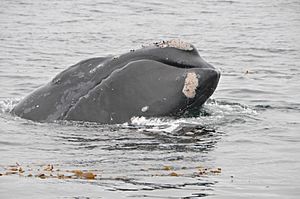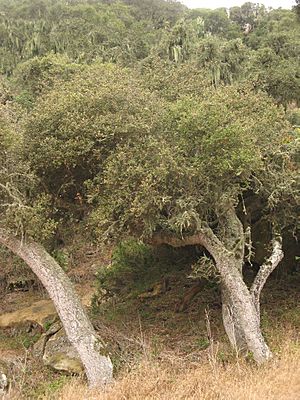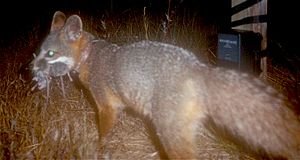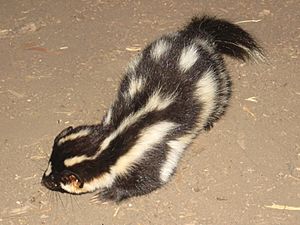Wildlife of the Channel Islands of California facts for kids
The wildlife of the Channel Islands of California is super interesting and diverse! These islands are home to many endemic species, which means they are found only there and nowhere else in the world. While the land animals are a bit limited – for example, the small island fox is the only large native predator – the ocean around the islands is full of amazing marine life. You can find everything from giant kelp forests to great white sharks swimming in these waters.
Contents
Amazing Island Plants

The Channel Islands have many unique plants, including special types of pine, oak, and the island tree mallow. For example, Santa Rosa Island has two groups of a rare Torrey pine subspecies. This pine, called Pinus torreyana var. insularis, grows only on this island. Torrey pines are actually the rarest pine species in the United States!
The islands also protect many other rare and endangered plants. These include the island barberry, the island rushrose, and the Santa Cruz Island lace pod. Underwater, huge giant kelp forests surround the islands. These kelp forests are like underwater jungles. They provide food and safe homes for many other marine animals.
Protecting Native Plants
Sometimes, plants that are not native to the islands, called invasive species, cause problems. For example, the Australian blue gum tree, olive tree, sweet fennel, and Harding grass have been brought to the islands. They compete with native plants for sunlight, nutrients, and water.
The Australian blue gum tree is especially tricky. Its fallen leaves release chemicals that stop other plants from growing nearby. Also, some of these non-native plants, like the blue gum and Harding grass, catch fire much more easily than native plants. This makes wildfires a bigger danger for the islands.
The ocean floor around the islands is also full of life. You can find many types of seaweed, sea urchins, and other marine plants living there.
Animals of the Channel Islands
The waters around the Channel Islands are home to many amazing animals. Sea lions are very common here. Large sharks like great whites, bulls, and tigers swim in these seas. Even Orcas (killer whales) sometimes appear near the islands! A large group of western gulls used to live on Anacapa Island.
Unique Island Animals
The Channel Islands and their surrounding waters are special because they have many endemic animal species and subspecies. Remember, "endemic" means they are found only here! Some of these unique animals include the Channel Islands deer mouse, the Channel Islands spotted skunk, and the island scrub jay. There are also special birds like the San Clemente loggerhead shrike and the San Clemente Bell's sparrow.
Many large marine mammals visit or live near the islands. These include Pacific gray whales, blue whales, humpback whales, and California sea lions. They come here to breed or find food. Seabirds like western gulls, bald eagles, pigeon guillemots, and Scripps's murrelets also use the islands. They find shelter and safe places to raise their young here.
The island fox is a very special animal. It is California's smallest native dog-like animal. It almost disappeared in the late 1990s but has made an amazing comeback! The islands also have unique reptiles, like the island fence lizard and island night lizard. You can also find the Channel Islands slender salamander, which is an endemic amphibian.
Sometimes, animals that are not native, like feral (wild) cows, sheep, and pigs, can also be found on the islands.
Who Eats What? The Island Food Chain
In any ecosystem, animals and plants are connected by what they eat. This is called a food chain. At the very bottom of the food chain are the plants. They make their own food using sunlight.
Next come the animals that eat plants. On the Channel Islands, this includes deer mice and small animals like insects, lizards, and some birds.
Then come the predators, which are animals that hunt and eat other animals. On the Channel Islands, these include sharks, orcas (which are top predators), eagles, and foxes.
The island fox is a good example of how the food chain works. It eats many different things! Its diet includes fruits, insects, birds, eggs, crabs, lizards, and small mammals, like deer mice.
Unique Land Mammals
The Channel Islands are home to only three native land mammals. These are the island deer mouse, the island spotted skunk, and the island fox.
Deer Mouse
The deer mouse lives on all five of the Channel Islands. It is very tough and can survive even when there isn't much fresh water. This is important on islands like Santa Barbara Island and Anacapa Island, which don't have any rivers.
Spotted Skunk
The spotted skunk is known to live on Santa Cruz Island and Santa Rosa Island. It used to be found on San Miguel Island too, but it's thought to have disappeared from there. While Santa Cruz Island has some skunks, Santa Rosa Island is home to over three thousand of them!
Island Fox
The island fox is the largest native land mammal on the Channel Islands. It lives on three of the five islands: Santa Cruz, Santa Rosa, and San Miguel. You won't find them on Santa Barbara or Anacapa islands. This is because those islands don't have enough fresh water for them to survive.




